A brief visit to Brazilian Falls, Rivers and Wildlife
A new (but short) adventure – more organised than our normal as we have organised this entire trip (apart from flights) through an agent – mainly because we ran out of decent internet and research time but also we were struggling to find available accommodation (much of it seems to be stitched up to agents).
After 3 flights, Guayaquil in Ecuador to Bogota, then Sao Paulo and on to Foz do Iguazu Brazil we were exhausted. Delay on arriving at custom’s and the staff changed shifts. You would think not an issue but then the new staff could not log in so the queue got longer and longer and no-one went anywhere. Didn’t help much at the next check in when it seemed like the whole Brazilian Olympic & Football teams plus associated large containers were checking in at the same time, with only 2 people on counter and 3 plane loads of people trying to check in. Rest of the day – nothing much.
The airbnb we chose is lovely with a great garden and lots of birds. Sitting outside there is lots of rustling in the trees – and out pop a family of Coati.
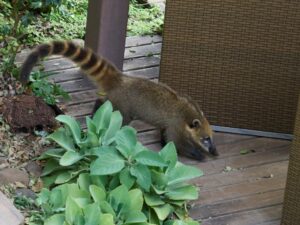
Started to see lots of smoke haze from fires and smell it. Fires not that close though when checking current fire map. We were all around the area below – the closest we got was about 20km but mostly around 100km.
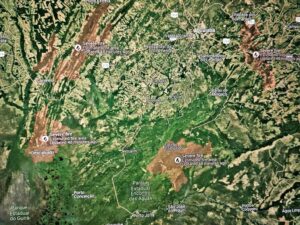
Lazy day today, off to see the falls by helicopter – WOW incredible.
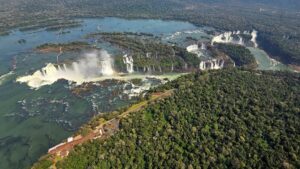
I was expecting the falls to be impressive but had not realised that the Dam is also an incredible feat of engineering and quiet a sight.

Pity about the smoke haze, not great for the photos. We also went to the three borders area, not that impressive but interesting in a way. Brazil bottom left, Argentina Top Left and Paraguay right.
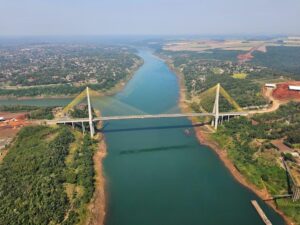
Birding and falls for 3 days, two on the Argentinian side and one on the Brazilian side.
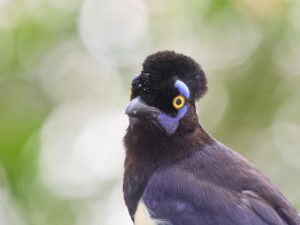
Our guide was brilliant and the day’s on the Argentinian side were fantastic, lots of interesting birds and wildlife and the falls – the power is incredible, you really feel it, certainly would not survive falling into it. You can see in the picture below how close you walk to the falls.
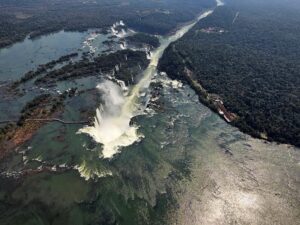
Marcus our guide got really excited when he spotted a Water Tyrant (bird) as there has only one other recorded sighting there.
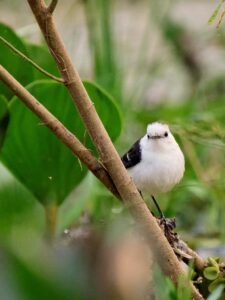
This side was not too crowded either, just wish we had more time to do more of the trails and viewpoints of the falls, even starting at 5am the day just disappears. You get so very close, almost on top of the U bend they called Devil’s Throat and we found the thundering water very impressive – what must it be like in the wet season – this is the end of the dry?
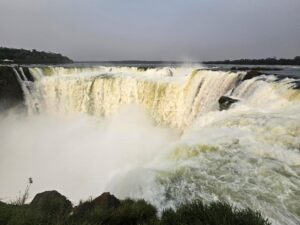
The falls are actually multiple falls – around 275, some are quite small but running down some really pretty vegetation. So many butterflies too, not only in numbers but in species.
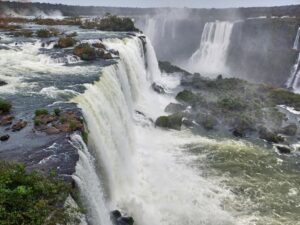
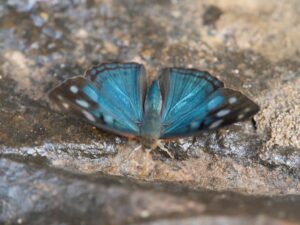
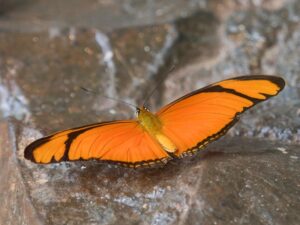
The Brazilian side was good but not as good for 2 reasons (in our opinion) the falls are more scenic this side – ie more large vista’s, not the power of closeness.
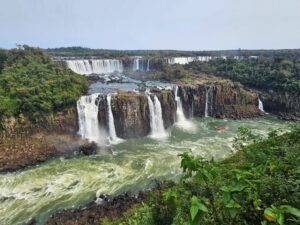
Secondly it is SO crowded – not our cup of tea. But there are more walking trails and less people going on the jungle trails so that was a plus. Good birds here too but much quieter than the other side but not many good photos due to haze.
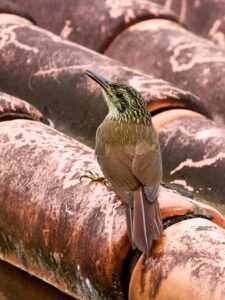
A lazy day before heading back to Sao Paulo overnight and off up to Cuiaba. Elaine & Aynore picked us up and off we headed for a long drive north to the Amazonian area and a brand new lodge called Cunhatai Pora. An amazing place with a wonderful owner – we were the first guests. All the staff were wonderful, the lodge and grounds were great and all set in a massive reserve with all sorts of wildlife and birds. Our first morning out we saw new tracks of Puma, Jaguar and Ocelot plus on the way back some new Quills from a Porcupine.
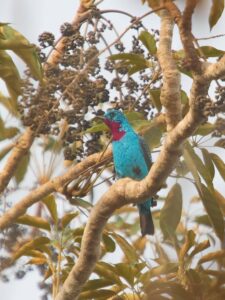
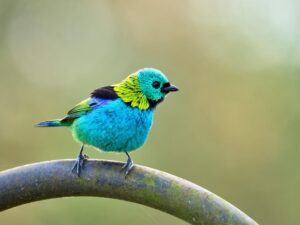
4 nights and plenty of forest walks, river and lake trips and a night safari. The food was great too – always a bonus. A rescue Tapir also wanders the grounds which is lovely to see, it is also now pregnant from a wild Tapir so great hope for the future generation.
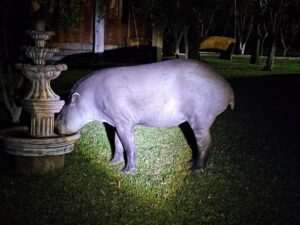
One afternoon we went for a drive to a nearby farm that also has a reserve, here we saw more wild Tapir, lots of nesting macaw’s, a very large bird I had never heard of a Red Legged Seriema and (very excited) an Armadillo crossing the road – not a great picture as by the time we stopped and jumped out of the car it was off into the field. I had all but given up expecting to find one so very happy.
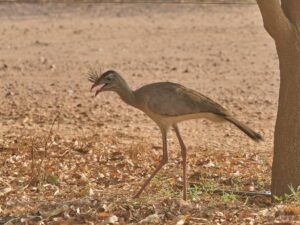
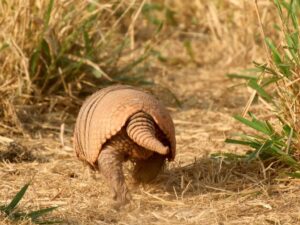
The Pantanal is our next and final stop in Brazil – again for 4 nights as we are determined to find a Jaguar (and an Anaconda). It is another long haul to get there by road (with stops it took nearly 10 hours). Great birds and wildlife along the last 140km of rough dirt, very exciting.
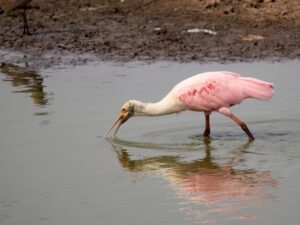
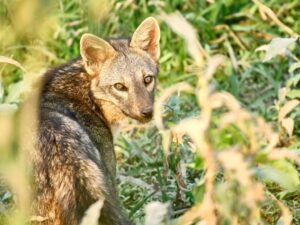
Lots of Capybaras on the lawn outside our room and on the river bank which saves using lawnmowers.
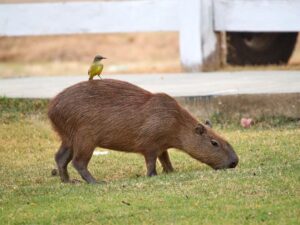
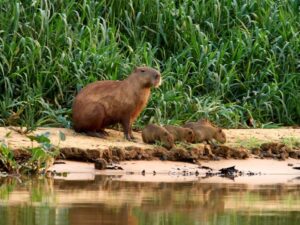
Also there was a Jabiru who was waiting for the fishermen to come back. Didn’t really appreciate how tall they are till we saw one standing next to a person (no camera at the time so only photos minus people, but the fish was very big).
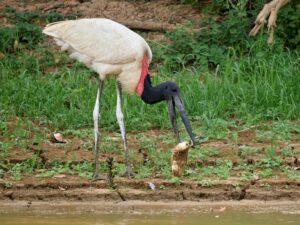
Not sure why I thought we might not find Jaguar’s as we saw 4 on day 1. The first one was just sleeping, then 3 together.
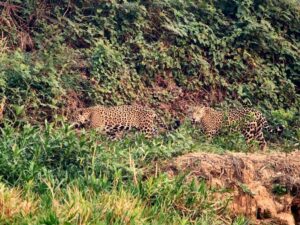
Lots of birds, some monkeys and plenty of Caiman.
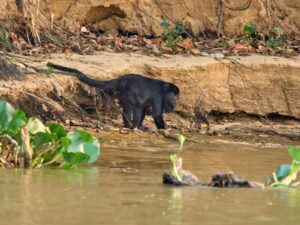
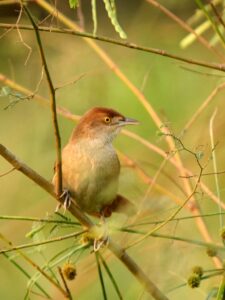
One of the other mammals I had really wanted to see was a Giant Otter -we saw 3 groups of them, one with young. Really great to watch them in and out of the river.
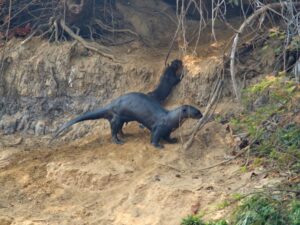
We tried over the days to find an Anaconda, but no luck so I put that out of my head. But then – on the last river trip in the afternoon we found a Jaguar hunting, stopped to watch and low and behold it caught an Anaconda – not sure that was quite how I had wanted to see one, dangling out of Jaguar mouth – but then again……
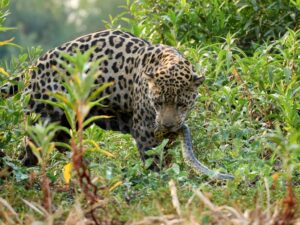
On arriving back we see our transport (a 4×4) near to newly arrived transport (small plane).
Nice but I preferred to see the scenery and the birds along the route – including a Crab Eating Fox. Had a puncture on way back to add to the fun (40C), hard to change due to condition of road and tyre on downside of slope.
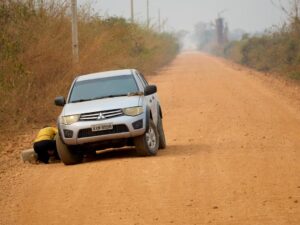
The flights back were very hazy and could see smoke from fires billowing up from airplane. Birds we saw 352 species of which 207 were new to us. Putting us 21st in the world for this year according to Cornell University’s ebird site. By the way Steve found this accidently recently, we were not aiming for it and did not even know of it.
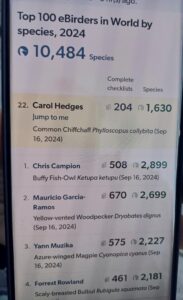
8 Jaguars of feline variety, monkeys, birds and surrounded by bush fires the nearest was 20kms away. Nature is amazing, you just have to get out and find it.
BIRD & WILDLIFE IDENTIFIED:
Birds:
Amazon Kingfisher
Amazonian Antshrike
American Pygmy Kingfisher
Anhinga
Bananaquit
Band-tailed Manakin
Bank Swallow
Bar-breasted Piculet
Bare-faced Curassow
Barn Owl
Bat Falcon
Bay-headed Tanager
Black Skimmer
Black Vulture
Black-backed Water-Tyrant
Black-banded Woodcreeper
Black-capped Donacobius
Black-capped Foliage-gleaner
Black-collared Hawk
Black-crowned Night Heron
Black-eared Fairy
Black-faced Antbird
Black-faced Dacnis
Black-fronted Nunbird
Black-fronted Piping-Guan
Black-girdled Barbet
Black-goggled Tanager
Blackish Nightjar
Black-tailed Trogon
Black-throated Mango
Blue Dacnis
Blue Ground Dove
Blue-and-yellow Macaw
Blue-black Grassquit
Blue-crowned Parakeet
Blue-crowned Trogon
Blue-headed Parrot
Blue-necked Tanager
Blue-tufted Starthroat
Bluish-grey Saltator
Boat-billed Flycatcher
Boat-billed Heron
Brazilian Tinamou
Brown Tinamou
Brown-chested Martin
Buff-necked Ibis
Buff-throated Woodcreeper
Burrowing Owl
Capped Heron
Cattle Tyrant
Chaco Chachalaca
Chestnut-bellied Euphonia
Chestnut-bellied Guan
Chestnut-bellied Seedeater
Chestnut-eared Aracari
Chestnut-vented Conebill
Chivi Vireo
Chopi Blackbird
Chotoy Spinetail
Cinnamon-throated Hermit
Cocoa Thrush
Cocoi Heron
Common Pauraque
Crane Hawk
Creamy-bellied Thrush
Crested Becard
Crested Caracara
Crested Oropendola
Curl-crested Jay
Dot-eared Coquette
Double-collared Seedeater
Dwarf Tyrant-Manakin
Eared Dove
Eastern Olivaceous Flatbill
Elegant Woodcreeper
Epaulet Oriole
Euler’s Flycatcher
Flame-crested Tanager
Flavescent Warbler
Forest Elaenia
Fork-tailed Flycatcher
Fork-tailed Palm Swift
Fuscous Flycatcher
Gilded Hummingbird
Glittering-bellied Emerald
Glittering-throated Emerald
Golden-crowned Warbler
Gould’s Toucanet
Great Black Hawk
Great Dusky Swift
Great Egret
Great Kiskadee
Greater Ani
Greater Rhea
Greater Thornbird
Green Ibis
Green Kingfisher
Green-headed Tanager
Greenish Tyrannulet
Green-tailed Goldenthroat
Grey Tinamou
Grey-breasted Martin
Grey-breasted Sabrewing
Grey-cowled Wood-Rail
Grey-fronted Dove
Grey-headed Tanager
Greyish Baywing
Greyish Mourner
Guira Cuckoo
Harpy Eagle
House Sparrow
House Wren
Hyacinth Macaw
Jabiru
King Vulture
Large Elaenia
Large-billed Tern
Lesser Kiskadee
Lesser Woodcreeper
Lesser Yellow-headed Vulture
Lesser Yellowlegs
Lettered Aracari
Limpkin
Little Blue Heron
Little Cuckoo
Little Nightjar
Little Woodpecker
Long-billed Starthroat
Masked Gnatcatcher
Masked Tanager
Mato Grosso Antbird
Monk Parakeet
Natterer’s Slaty-Antshrike
Neotropic Cormorant
Ochre-breasted Foliage-gleaner
Olivaceous Woodcreeper
Olive-sided Flycatcher
Orange-backed Troupial
Orange-cheeked Parrot
Orange-winged Parrot
Orinoco Goose
Osprey
Pale-breasted Thrush
Pale-legged Hornero
Pale-rumped Swift
Pale-vented Pigeon
Palm Tanager
Pantanal Snipe
Paradise Tanager
Peach-fronted Parakeet
Picazuro Pigeon
Picui Ground Dove
Pied Plover
Plain Antvireo
Plain Tyrannulet
Plain-winged Woodcreeper
Planalto Woodcreeper
Plumbeous Ibis
Plush-crested Jay
Point-tailed Palmcreeper
Pompadour Cotinga
Purple Honeycreeper
Purple Martin
Purplish Jay
Razor-billed Curassow
Red-billed Scythebill
Red-crowned Ant-Tanager
Reddish Hermit
Red-legged Seriema
Red-necked Woodpecker
Red-rumped Cacique
Red-shouldered Macaw
Red-throated Piping-Guan
Red-winged Tinamou
Ringed Kingfisher
Riverbank Warbler
Roadside Hawk
Roseate Spoonbill
Rose-breasted Chat
Ruby-crowned Tanager
Ruddy Ground Dove
Ruddy Quail-Dove
Rufescent Tiger-Heron
Rufous Cacholote
Rufous Casiornis
Rufous Hornero
Rufous-bellied Euphonia
Rufous-bellied Thrush
Rufous-breasted Hermit
Rufous-capped Motmot
Rufous-collared Sparrow
Rufous-margined Antwren
Rufous-tailed Jacamar
Rufous-throated Sapphire
Rusty-backed Spinetail
Rusty-collared Seedeater
Rusty-fronted Tody-Flycatcher
Rusty-margined Flycatcher
Rusty-margined Guan
Saffron Finch
Saffron-billed Sparrow
Sao Paulo Bristle-Tyrant
Saturnine Antshrike
Savanna Hawk
Sayaca Tanager
Scaled Dove
Scaled Pigeon
Scaly-headed Parrot
Screaming Cowbird
Screaming Piha
Shiny Cowbird
Short-billed Honeycreeper
Short-crested Flycatcher
Short-tailed Antthrush
Short-tailed Hawk
Sibilant Sirystes
Sick’s Swift
Silver-beaked Tanager
Silvered Antbird
Slaty-capped Shrike-Vireo
Smooth-billed Ani
Snail Kite
Snowy Egret
Solitary Black Cacique
Solitary Sandpiper
Solitary Tinamou
Southern Antpipit
Southern Beardless-Tyrannulet
Southern Lapwing
Southern Mouse-colored Tyrannulet
Southern Rough-winged Swallow
Southern Screamer
Southern Scrub-Flycatcher
Southern White-fringed Antwren
Spangled Cotinga
Spot-billed Toucanet
Spotted Nothura
Squirrel Cuckoo
Streak-capped Antwren
Striated Antbird
Striated Heron
Subtropical Doradito
Swallow Tanager
Swallow-tailed Kite
Swallow-tailed Manakin
Swallow-winged Puffbird
Thrush-like Wren
Toco Toucan
Tropical Kingbird
Tropical Parula
Tropical Royal Flycatcher
Turkey Vulture
Turquoise Tanager
Turquoise-fronted Parrot
Unicolored Blackbird
Vermilion Flycatcher
Versicolored Emerald
Violet-capped Woodnymph
Wattled Jacana
Western Cattle Egret
Whistling Heron
White-bellied Seedeater
White-bellied Tody-Tyrant
White-crested Elaenia
White-crested Tyrannulet
White-eyed Foliage-gleaner
White-headed Marsh Tyrant
White-lined Tanager
White-lored Spinetail
White-naped Jay
White-naped Xenopsaris
White-necked Jacobin
White-tailed Goldenthroat
White-tailed Hawk
White-throated Kingbird
White-throated Piping-Guan
White-throated Toucan
White-tipped Dove
White-wedged Piculet
White-winged Swallow
Wood Stork
Yellow-backed Tanager
Yellow-billed Cardinal
Yellow-billed Tern
Yellow-chevroned Parakeet
Yellow-chinned Spinetail
Yellow-olive Flatbill
Yellow-rumped Cacique
Yellow-tufted Woodpecker
Zigzag Heron
Zimmer’s Tody-Tyrant
Butterflies & Moths:
Adelpha
Aeria Olena
Blue Banded Morpho
Catonephele
Diaethria Phlogea
Doxocopa
Dynamine Tithia
Grey Cracker
Hypena Moth
Julia
King Swallowtail
Malachite Butterfly
Siproeta Epaphus
Reptiles & Other Stuff
Argentine Black and White Tegu Lizard
Cayman
False Coral Snake
Golden Tailed Lizard
Green Iguana
Honey Ant
Horse Fly
Leaf Cutter Ants
Megacephala Beetle
South American Ground Lizard
Southern Spectacled Caiman
Violet Winged Grasshopper
Yacare Caiman
Wildlife
Azara’s Agouti
Black and Gold Howler Monkey
Black Faced Spider Monkey
Black Hooded Capuchin Monkey (Azara’s)
Black Horned Capuchin Monkey
Black Tailed Marmoset Monkey
Brazilian Cavi (Small Guinea Pig)
Brazilian Guinea Pig
Brown Rocket Deer
Capybara
Chaconne Titi Monkey
Crab Eating Fox
Grey Four Eyed Opossum
Giant River Otter
Jaguar
Marsh Deer
Red Rocket Deer
Seven Banded Armadillo
South American (Lowland) Tapir
Spotted Paca
Tayra
Water Buffalo
Williams South American Side Necked Turtle
Wolly Opossum
THINGS TO DO
Brazil/Argentine Iguaza Parks
Both are pretty amazing and if you have time it is well worth doing both sides as they are so different. I personally liked the Argentinian side better as the force of the water was just incredible. The Brazilian side is better for more scenic views. I would say in Argentina you feel the falls, in Brazil you look at them. Both different experiences. The park trails were great in both, not too busy but the falls on the Brazil side was crazy – so many people.
Nature
Amazon Lodges, treks and River Trips
Pantanal River Trips
Both the above are fantastic for birds and animals – in different ways with different species. I am sure a lot more of Brazil would produce a lot more but no time on this trip. Allow a few days in each place as the distances are large – unless of course like some we saw you take private aircraft in between (you need a big wallet).
WHERE TO STAY
Our favourite place was Cunhatai Pora Lodge for the whole experience. Fantastic Lodge, amazing owner and great birds and wildlife.
In Iguazu we stayed at a great BNB called Grey House – a little hard to find but has all you need in a great garden environment next to a river and close to town.
WHERE TO EAT
We self catered in Iguazu and the other lodges were full board so no recommendations.
COSTS
FUEL:-
5 BR per litre for diesel on average.
ALCOHOL:-
10 BR upwards for a local litre of spirits in a supermarket.
6 BR for an imported beer in a supermarket.



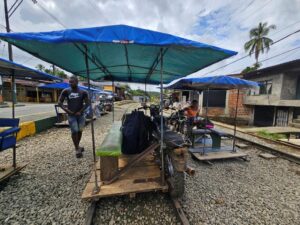
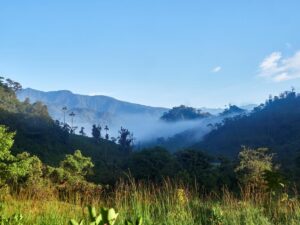

Hi Carol and Steve, Wow amazing waterfalls. You got close to the wildlife, not scared ? i would be ) Airport cues sounded terrible Thanks for the blog. Shona
One word for that – impressive!
Thankyou